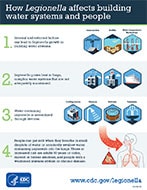- By Marketing
- In Mold Removal
Legionella (Legionnaires’ Disease and Pontiac Fever)
Disease Specifics
The following sections provide information about the bacterium that causes legionellosis, as well as how it causes disease.
Etiologic Agent and Transmission
Bacteria of the genus Legionella cause Legionnaires’ disease and Pontiac fever, collectively referred to as legionellosis. There are at least 60 different species of Legionella; most are considered pathogenic, but most disease is caused by Legionella pneumophila, particularly serogroup 1. Legionella is transmitted via inhalation of aerosolized water containing the bacteria. Less commonly, Legionella can be transmitted via aspiration of drinking water. Legionella is not usually transmitted from person-to-person. However, a single episode of possible person-to-person transmission of Legionnaires’ disease has been reported. [1]
Risk Factors
Risk factors for legionellosis include:
- Age ≥50 years
- Smoking (current or historical)
- Chronic lung disease (such as emphysema or COPD)
- Immune system disorders due to disease or medication
- Systemic malignancy
- Underlying illness such as diabetes, renal failure, or hepatic failure
- Recent travel with an overnight stay outside of the home, including stay in a healthcare facility
- Exposure to hot tubs
How Legionella Affects Building Water Systems and People
 Learn four key steps that can lead to Legionella growing in building water systems and spreading to people.
Learn four key steps that can lead to Legionella growing in building water systems and spreading to people.Sources of Legionella
Legionella can be found in natural, freshwater environments, but generally is not present in sufficient numbers to cause disease. In human-made water systems, like the premise plumbing of large buildings (consisting of water heaters, storage tanks, and pipes), cooling towers, decorative fountains, or hot tubs, Legionella can grow and be transmitted to susceptible hosts via aerosolization.
Because hotels, resorts, and cruise ships often use large, complex water systems and other aerosol-generating devices, travel is a risk factor for disease. This is also true for hospitals and long-term care facilities, which also host susceptible populations.
Pathogenesis
In water, Legionella grows and multiplies within amoebae and ciliated protozoa, which are small one-celled organisms. In addition to providing nutrients for replicating and growing Legionella, protozoa also provide a shelter that protects Legionella from adverse environmental conditions, such as extreme temperatures and chemicals like chlorine. Human immune cells called alveolar macrophages look very similar to protozoa. When in human lungs, Legionella invades and grows within alveolar macrophages, mistaking them for their natural host and causing disease.
Burden of Disease
Rates of reported cases of Legionnaires’ disease continue to rise in the United States. More than 6,000 cases were reported in 2015. However, because Legionnaires’ disease is likely underdiagnosed, this number may underestimate true incidence.
Related Pages
- Legionnaires’ Disease Fact Sheet for Patients
English[1 page] | Spanish[1 page] - Legionnaires’ Disease Fact Sheet for Clinicians[2 pages]
- Legionnaires’ Disease on Rise in US—2016 Update
https://www.cdc.gov/legionella/clinicians/disease-specifics.html
